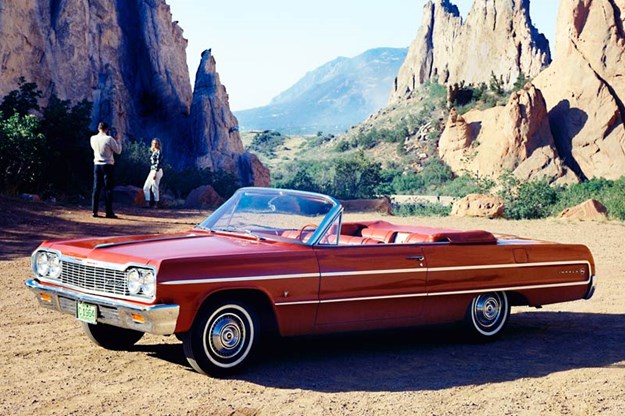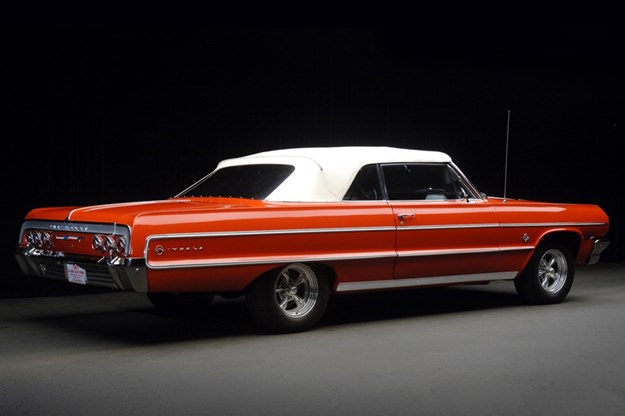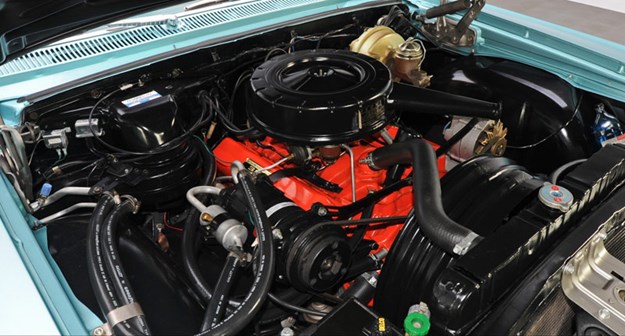1961-1964 Chevrolet Impala - Buyer's Guide



|
Lots of choice between locally-assembled and imported models. Not difficult to find, but are becoming more costly
Chevrolet Impala
The year of 1961 brought an entirely new shape and purpose to General Motors’ biggest brand. Billed as the ‘Jet Smooth Chevrolet’, GM’s market leader pushed the attributes of abundant space and aircraft-inspired performance.
Heading Chevrolet’s range for ‘61 was the stylish and fairly plush Impala SS. Impalas came with two or four doors, as a hardtop or convertible, and a range of V8 engines including the ferocious 409 cubic inch race motor. Styling was fresh and distinctive too, with a slimline ‘bubble top’ roofline characterising two-door versions.
With impossibly thin pillars front and rear, Impala Hardtops appeared from a distance to have a canopy that was nothing more than a glass bubble. It was a contrivance very obviously inspired by General Motors’ glass-topped Motorama show cars from the 1950s.

All didn’t go well in the showroom however. Chevrolet had been dominant during 1960, outselling Ford by 220,000 cars, so the 1961 results must have come as a shock when it lost out by the slimmest of margins.
Come 1962 and the Impala took on a more formal look, with heavier, Thunderbird-style rear pillars. Bubble top buyers could still enjoy the glasshouse but they had to do it from behind the wheel of a lower-spec Bel-Air.
| Buyer's Guide: 1961 Chev Impala Sport coupe
Australian assembled Chevrolets from this era were all four-door Bel-Air sedans that came to us in RHD kits from Canada. We saw as well and in considerable numbers, two-door and four-door pillarless Impalas that arrived directly from US manufacturing plants and ready for RHD conversion.
These export cars almost always came with 4.6-litre ‘283’ V8s, or after its 1962 introduction, the new ‘327’. Even in the USA, big-block cars were scarce and during 1961 just 142 of the long-stroke, 409 cubic inch engines were fitted to Impalas.
Chevrolet’s shape for 1963-64 did change but not to any radical extent. If anything, the styling became more conservative, leaving the flashy stuff to Pontiac.

As a reward for judicious sheet metal changes, the inevitable trim alterations and sharp pricing, Chevrolet during 1964 was rewarded with a new US sales record and 800,000-unit lead for the year over Ford.
| 2020 Market Review: Chevrolet 1955-1964
With 400,000 SS Impalas sold during a four year period, the task of finding one in Australia isn’t especially difficult and unsurprisingly easy in the USA. However, it is becoming more costly.
Look back a decade to the depths of the Global Financial Crisis and a typical SS two-door (LHD, 283 V8, automatic) was selling in the region of $40,000, with 1958-60 versions $10,000 more. Delve today into the classifieds and you’re more likely to find ‘wanted’ ads than multiple cars for sale. When you do find one, it may have at least some modification and be priced at more than $60,000.
Given their scarcity, SS convertibles with big-block engines will attract significant money and exceptional cars can reach US$100,000. Impalas like these are virtually never seen in Australia but considering they now cost about the same as a 350-engined Monaro, importing one looks viable.
VALUE RANGE: Chevrolet Impala (Two-door 327 auto)
Fair: $20,000
Good: $42,000
Excellent: $60,000
(Note: exceptional cars will demand more)
BUYER'S CHECKLIST

Body & chassis
Unless you buy an unrestored car or one that hasn’t seen a panel shop for a decade or three, rust should not trouble most Impala buyers. To get a decent sense of a car’s condition, look at window surrounds, inner sills and floors, under the doors and wheel-arch lips (which sometimes have been remade entirely from body filler). The rear axle attachment points are worth a look too. New chrome, glass and stainless are available and not too expensive - side windows for two-door cars with mountings at $US370 per pair. Do get the right bumpers though, because some ‘61s had single-piece bumpers, others three piece and the mounts are different.

Engine & transmission
Chevrolet engines from the 1960s are basic and still freely available. Complete rebuild kits for V8s of all sizes can be bought locally, although parts for the big-block may need to be specially imported. Overheating is a typical problem which can lead to cracked piston rings, loss of compression and oil burning. Specialised inlet manifolds that allow big-block owners to fit ‘dual quad’ carburettors are available and cost around US1000 plus freight. Most cars of this age have two-speed Powerglide transmission which is durable and easy to recondition. Three-speed Turboglide transmission is viable if the Powerglide is beyond repair.
Suspension & brakes
Given the money being sought for 1960s Impalas, the cost of completely rebuilding the cars’ very basic suspension is relatively tiny. Everything apart from springs and shock absorbers can be bought in kits put together by parts suppliers at about $600. New front and rear springs to factory specification cost about $350 per set, with lowered coils at around $600.Standard rims and tyres don’t deliver the grip these cars deserve, so stacking the originals in the garage for show use and arranging some after-market wheels with lower-profile rubber (although not below 60 Series) is wise. Parts to recondition the all-drum brakes are available but so too are low-cost conversions to front discs.

Interior & electrics
Water leaking between the side windows collects under seats and can cause rust and mould. Flattened seat foam and springs are other areas to check when buying a Chevy of this age because seat refurbishing is expensive. If the car has been switched to RHD check that the windscreen wipers have been repositioned and that the seat belt shoulder strap mounting isn’t going to irritate unbearably. Trim for cars with bench or bucket front seats is available pre-cut or in rolls to match a wide range of interior colours. Pre-assembled door trims cost $700 per side, so try to find a car which already has had them replaced. Ancient power window mechanisms, unless recently overhauled, may be slow to move and noisy. Repair kits come from US suppliers at around A$400 per side.
1961-1964 Chevrolet Impala specs
Number made: 438,000 (all SS Impala 1961-64)
Body styles: All-steel separate body/chassis two-door coupe/convertible
Engine: 4662, 5363 or 6702cc V8 with overhead valves & single or dual downdraft carburettor
Power & torque: 186kW @ 4400rpm, 472Nm @ 2800rpm (327 single carb)
Performance: 0-96km/h 10.4 seconds, 0-400 metres 17.8 seconds (327 auto)
Transmission: 3 or 4-speed manual, 2 speed automatic
Suspension: Independent with coil springs, upper & lower control arms, telescopic shock absorbers and anti-roll bar (f) Live axle with coil springs, locating links and telescopic shock absorbers (r)
Brakes: Drum (f) drum (r) power assisted
Tyres: 7.50x14 cross ply
Unique Cars magazine Value Guides
Sell your car for free right here
Get your monthly fix of news, reviews and stories on the greatest cars and minds in the automotive world.
Subscribe

.jpg)
![1967 CHEVROLET IMPALA [Empty]](http://assets.primecreative.com.au/imagegen/cr/100/75/assets/momoads/2023/11/21/133520/2558_1.jpg)











